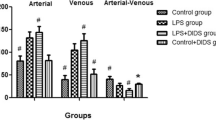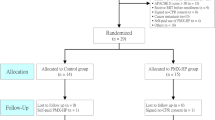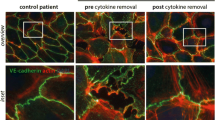Abstract
Objective
To investigate the effects of different conditions of flow on endotoxin induced adhesion of human red blood cells (RBC) to human umbilical vein endothelial cells (HUVEC).
Design and setting
Prospective, randomized, controlled in vitro study in a university-affiliated cell biology laboratory.
Subjects
Human erythrocytes, human vascular endothelial cells.
Interventions
Superfusion of HUVEC monolayers with human erythrocytes incubated with either saline (CON) or endotoxin (ETX) with different flow pattern (basic flow rates of 0.65 or 1.3 ml/min; intermittent flow, IMF). The CON/0.6, CON/1.3, CON-IMF/1.3 (n=7/group) groups served as control, and in test groups ETX/0.6, ETX/1.3, ETX-IMF/0.6, and ETX-IMF/1.3 (n=7/group) both RBC and HUVECs were incubated with ETX and flow pattern and rates varied. In the IMF experiments flow rates of 0.65 and 1.3 ml/min were combined with stop-and-go flow pattern.
Measurements and results
At continuous flow of 0.65 ml/min erythrocyte adhesion was 61±5 cells/mm2 in CON and 172±25 cells/mm2 after ETX. When flow rate was increased to 1.3 ml/min, adhesion decreased to 27±4 cells/mm2 in CON and 93±18 cells/mm2 after ETX. IMF conditions had no effect on RBC adhesion of naive RBC but increased the number of adhesive erythrocytes after incubation with ETX both at 0.65 ml/min (287±33 cells/mm2) and at 1.3 ml/min (148±13 cells/mm2).
Conclusions
RBC adhesion to vascular endothelium is affected by rate and pattern of blood flow. Higher flow rates or shear forces reduce RBC adhesion while stop-and-go flow pattern favored adhesion of ETX-treated erythrocytes to HUVECs. These findings suggest that altered RBCs interact with altered flow patterns potentially contributing to the microcirculatory injury observed in sepsis.





Similar content being viewed by others
References
Telen MJ (2000) Red blood cell surface adhesion molecules: their possible roles in normal human physiology and disease. Semin Hematol 37:130–142
Tissot Van Patot MC, MacKenzie S, Tucker A, Voelkel NF (1996) Endotoxin-induced adhesion of red blood cells to pulmonary artery endothelial cells. Am J Physiol 270:L28–L36
Eichelbrönner O, Sielenkämper A, Cepinskas G, Sibbald WJ, Chin-Yee IH (2000) Endotoxin promotes adhesion of human erythrocytes to human vascular endothelial cells under conditions of flow. Crit Care Med 28:1865–1870
Morigi M, Zoja C, Figliuzzi M, Foppolo M, Micheletti G, Bontempelli M, Sarronni M, Remuzzi G, Remuzzi A (1995) Fluid shear stress modulates surface expression of adhesion molecules by endothelial cells. Blood 85:1696–1703
Lipowsky HH, Riedel D, Shi GS (1991) In vivo mechanical properties of leukocytes during adhesion to venular endothelium. Biorheology 28–:53–64
Lawrence MB, McIntire LV, Eskin SG (1987) Effect of flow on polymorphonuclear leukocyte/ endothelial cell adhesion. Blood 70:1284–1290
Granger HD, Kubes P (1994) The microcirculation and inflammation: modulation of leukocyte-endothelial cell adhesion. J Leukoc Biol 55:662–675
Van Deventer SJH, Büller HR, ten Cate JW, Aarden LA, Hack CE, Sturk A (1990) Experimental endotoxemia in humans: analysis of cytokine release and coagulation, fibrinolytic and complement pathways. Blood 76:2520–2526
Lam C, Tyml K, Martin C, Sibbald W (1994) Microvascular perfusion is impaired in a rat model of normotensive sepsis. J Clin Invest 94:2077–2083
Knisely MH, Cowley RH, Hawthorne I, et al (1970) Experimental and clinical separation of hypovolemic and septic shock. Angiology 21:728–744
Whitworth PW, Cryer HM, Garrison RN, Baumgarten TE, Harris PD (1989) Hypoperfusion of the intestinal microcirculation without decreased cardiac output during live Escherichia coli sepsis in rats. Circ Shock 27:111–122
Hinshaw LB (1996) Sepsis/septic shock: participation of the microcirculation: an abbreviated review. Crit Care Med 24:1072–1078
Yoshida N, Granger DN, Anderson DC, Rothlein R, Lane C, Kvietys PR (1992) Anoxia/reoxygenation-induced neutrophil adherence to cultured endothelial cells. Am J Physiol 262:H1891–H1898
DeGrendele HC, Estess P, Siegelman MH (1997) Requirement for CD44 in activated T cell extravasation into an inflammatory site. Science 278:672–675
Robinson LA, Tu L, Steeber DA, et al (1998) The role of adhesion molecules in human leukocyte attachment to porcine vascular endothelium: implications for xenotransplantation. J Immunol 161:6931–6938
Clark RA, Alon R, Springer TA (1996) CD44 and hyaluronan dependent rolling interactions of lymphocytes on tonsillar stroma. J Cell Biol 134:1075–1087
Paloske BL, Howard RJ (1994) Malaria, red cell and the endothelium. Annu Rev Med 144:283
Roberts DD, Sherwood JA, Spitalnik SL, Panton LJ, Howard RJ, Dixxit VM, Frazier WA, Miller LH, Ginsbrug V (1985) Thrombospondin binds falciparum malaria parasitized erythrocytes and may mediate cytoadherence. Nature 318:64–66
Farquhar I, Martin CM, Lam C, Potter R, Ellis CG, Sibbald WJ (1994) Decreased Capillary Density in vivio in bowel mucosa of rats with normotensive sepsis. J Surg Res 61:190–196
Wautier JL, Paton RC, Wautier MP, Pintigny D, Abadie E, Passa P, Caen JP (1981) Increased adhesion of erythrocytes to endothelial cells in diabetes mellitus and its relation to vascular complications. N Engl J Med 305:237–242
Ockenhouse CF, Tegoshi T, Maeno Y, Benjamin C, Ho M, Kan KE, Thway Y, Win K, Aikawa M, Lobb R (1992) Human vascular endothelial cell adhesion receptors for Plasmodium falciparum-infected erythrocytes: roles for endothelial leukocyte adhesion molecule-1 and vascular cell adhesion molecule-1. J Exp Med 176:1183–1189
Cooke BM, Rogerson SJ, Brown GV, Coppel RL (1996) Adhesion of Malaria-infected red blood cells to chondroitin Sulfate A under flow conditions. Blood 88:4040–4044
Setty BN, Stuart MJ (1996) Vascular cell adhesion molecule-1 is involvled in mediating hypoxia-induced sickle red cell adherence to endothelium: potential role in sickle cell disease. Blood 88:2311–2320
Hebbel PR, Yamada O, Moldow CF, Jacob HS, White JG, Eaton JW (1980) Abnormal adherence of sickle erythrocytes to cultured vascular endothelium: a possible mechanism for microvascular occlusion in sickle cell disease. J Clin Invest 65:154–160
Cooke BM, Berendt AR, Craig AG, MacGregor J, Newbold CI, Nash GB (1994) Rolling and stationary cytoadhesion of red blood cells parasitized by Plasmodium falsiparum: separate roles for ICAM-1, CD-36 and thrombospondin. Br J Hemotol 87:162–170
Hebbel R (1997) Perspective series: Cell adhesion in vascular biology. Adhesive interactions of sickle erythrocytes with endothelium. J Clin Invest 99:2561–2564
Fong Y, Marano MA, Moldawer LL, Wei H, Calvano S, Keney JS, Allison AC, Cerami A, Shires GT, Lowry SF (1990) The acute splanchnic and peripheral tissue metabolic response to endotoxin in humans. J Clin Invest 85:1896–1904
Carlos TM, Harlan JM (1994) Leukocyte-endothelial adhesion molecules. Blood 84:2068–2101
Cooke BM, Coppel RL (1995) Cytoadhesion and falciparum malaria: going with the flow. Parasitol Today 11:282–287
Perry MA, Granger DN (1991) Role of CD11/CD18 in shear rate dependent leukocyte-endothelial cell interactions in cat mesenteric venules. J Clin Invest 87:1798–1804
Bienvenu K, Russell J, Granger DN (1993) Platelet-activating factor promotes shear rate dependent leukocyte adhesion in postcapillary venules. J Lipid Mediat 8:95–103
Worthen GS, Smedly LA, Tonnesen MG, Ellis D, Voelkel NF, Reeves TJ, Henson PM (1987) Effect of shear stress on adhesive interaction between neutrophils and cultured endothelial cells. J Appl Physiol 63:2031–2041
Spring FA, Parsons SF (2000) Erythroid cell adhesion molecules. Transfus Med Rev 14:351–363
Kalra VK, Rattan V, Sultana C, Shen Y, Johnson C, Meiselmann MH (1997) Sickle red cell interaction with endothelial cells augments the expression of adhesion molecules and transendothelial migration of monocytes. Microcirculation 4:130–136
Barabino GA, McIntire LV, Eskin SG, Sears DA, Udden M (1987) Endothelial cell interaction with sickle cell, sickle trait mechanically injured and normal erythrocytes under controlled flow. Blood 70:152–157
Acknowledgements
The authors thank Ron Noseworthy for his assistance in cell harvesting, Dr. Natale for his cooperation in tissue collection, and the nurses of the delivery ward of St. Joseph's Hospital for their generous help in collecting umbilical cords.
Author information
Authors and Affiliations
Corresponding author
Additional information
This research was supported by the Departments of Hematology and Critical Care Medicine, London Health Sciences Centre, London, Ontario, Canada.
Rights and permissions
About this article
Cite this article
Eichelbrönner, O., Sibbald, W.J. & Chin-Yee, I.H. Intermittent flow increases endotoxin-induced adhesion of human erythrocytes to vascular endothelial cells. Intensive Care Med 29, 709–714 (2003). https://doi.org/10.1007/s00134-003-1698-y
Received:
Accepted:
Published:
Issue Date:
DOI: https://doi.org/10.1007/s00134-003-1698-y




